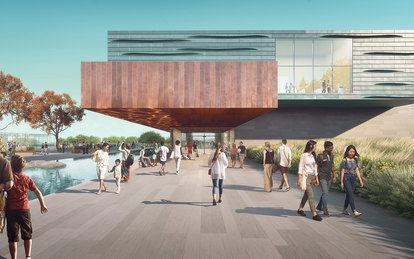SmithGroup's Design Concept for New Gilcrease Museum is Revealed

Today Gilcrease Museum (Tulsa, Okla.) unveiled the concept design for an entirely new facility that reimagines the museum from the ground up. The 83,500 square foot building is designed by SmithGroup, one of the nation's leading integrated design firms, to allow the museum to improve the visitor experience and better exhibit and care for their extensive collection of American art.
The concept for the new museum building is centered upon reconnecting humankind to nature. Located within the Osage Nation reservation boundaries, the new building design contains subtle references to Osage culture.
"It is important that the new Gilcrease Museum is of the spirit, history and people of its place. We are therefore weaving the naturally breathtaking landscapes with the phenomenal collection of art and the multitude of rich cultures present in this area of the country," said Ivan O'Garro, lead designer at SmithGroup.
The museum is conceived to align cardinal directions with natural elements and experiences: north/sky; south/earth; west/night; and east/day. The color and material palettes for the building reflect the art deco styles found throughout Tulsa, including the use of stone and gilded metals in concert with natural tones of the land and sky. The lower level of the building is comprised of earth tones, creating connection to the ground, while the upper level utilizes sky tones, blurring the line between architecture and sky.
A three-story atrium helps orient visitors while other spaces throughout the building frame views of Downtown and North Tulsa and panoramic views of the Osage Hills that will create experiential moments between visitors and the "Great American Landscape" that surrounds the museum and grounds.
The existing Gilcrease Museum facility was originally built in 1913 and expanded numerous times, most recently in 1987. Through extensive study, the design team and museum leadership determined the existing building required replacement to enable the long-term care of the collection. A new facility will provide opportunities to improve the visitor experience with larger galleries and more intuitive wayfinding.
"Gilcrease and its collection are deeply rooted in the history of Tulsa, and also reveal national and international narratives that continue to touch our daily lives," said Susan Neal, Executive Director at Gilcrease Museum. "Perhaps now more than ever, it is vitally important that we share these stories with as a broad an audience as possible to help us better understand ourselves and one another as well as introduce a new generation of visitors to the museum. The new Gilcrease will allow us to do just that."
Gilcrease Museum houses more than 350 years of American paintings, sculpture and works on paper including the world's largest public holding of art of the American West, a comprehensive collection of Indigenous works from 12,000 BCE to the 21st century, and more than 100,000 manuscript, photographs, maps, rare books and other materials related to the history of the Americas from the 15th-20th centuries as part of their Helmerich Center for American Research. In improved gallery space, Gilcrease will be able to utilize its collections to tell a richer, more nuanced story of American history and culture, offering multiple perspectives and exploring the relevance of the past to today.
A community engagement process early in design revealed strong desire to see the museum grounds incorporated into the overall visitor experience. SmithGroup is also developing a new master plan for the museum's campus that will continue to be refined through further consultations with the local community and tribal nations with connections to the land. The master plan seeks to activate outdoor spaces on the campus to allow people to connect with one another and nature. An envisioned network of new walking/biking trails will increase the community's access to Gilcrease.
SmithGroup's Cultural practice encompasses a network of specialty expertise, including planning, programming and design of museums and galleries, archives and collections care, visitor and interpretive centers, children's museums, science centers, arts education, performing arts and cultural landscapes. For more than half a century, the firm has delivered award-winning projects for some of the world's most iconic places and prestigious institutions. Some of its museum projects include the National Museum of African American History and Culture (Washington, DC); National Museum of the American Indian (Washington, DC); Detroit Institute of Art (Detroit, Mich.); Cranbrook Academy (Bloomfield, Mich.); and the concept design for the Richmond National Slavery Museum at the Lumpkin's Slave Jail Site/Devil's Half Acre (Richmond, Va.).
SmithGroup is provided integrated design services, including architecture, interior architecture and MEP engineering. SmithGroup is collaborating with a local team of small and diverse businesses in the Tulsa area, including associate architect 1Architecture (Tulsa); Howell & Vancuren (Tulsa) as landscape architect; Wallace Engineering (Tulsa) as civil engineer; and 360 Engineering Group (Tulsa) as structural engineer. Gallagher & Associates (Silver Spring, Md.) is the exhibit designer and is providing museum strategic and operations planning.
The new Gilcrease Museum is anticipated to be completed by the end of 2024.
For more information about SmithGroup, please visit our Company Fact Sheet.
The Thomas Gilcrease Institute of American History and Art (www.gilcrease.org), known as Gilcrease Museum, houses a comprehensive and interdisciplinary collection of more than 350,000 items reflecting the art, culture, and history of North America. The museum represents hundreds of Indigenous cultures from across North and South America, with works of art and material culture from 12,000 BCE to the 21st century. The collection includes more than 350 years of American paintings, sculptures, and works on paper, including the largest public holdings of art of the American West. The museum is owned by the City of Tulsa, which has partnered with The University of Tulsa to manage the museum.